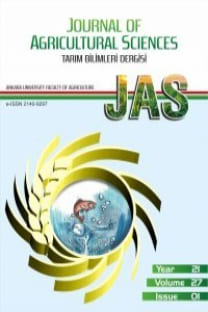Export Competitiveness of Türkiye Agri-food Products in the European Union and The Shanghai Cooperation Markets
Export Competitiveness of Türkiye Agri-food Products in the European Union and The Shanghai Cooperation Markets
___
- Balassa B (1965). “Trade liberalization and “revealed” comparative advantage”. The Manchester School of Economics and Social Studies 33(3): 99–123.
- Balassa B. (1977). Revealed comparative advantage revisited. The Manchester School of Economics and Social Studies 45(4): 327–344.
- Benesova I, Maitah M, Smutka L, Tomsik K & Ishchukova N (2017). Perspectives of the Russian agricultural exports in terms of comparative advantage. Agricultural Economics ‐ Czech 63(7): 318–330.
- Bojnec S & Fertö I (2009). Agro-food trade competitiveness of Central European and Balkan countries. Food Policy 34(5): 417–425.
- Cagatay S & Guzel A (2003). Review of agriculture and trade policies in Turkey, BSEC Trade Facilitation Project, FAO TCP/REP/2901.
- Cleves M A, Gould W W & Gutierrez R G (2010). An Introduction to Survival Analysis Using STATA. Stata Press, College Station, Texas.
- Erdem T (2020). Competitiveness of dried sector: A case study of World and Turkey. Agricultural Economics ‐ Czech 66(8): 365–372.
- Bashimov G (2017). Comparative advantage in agro-food products of Turkey. Turkish Journal of Agricultural and Natural Sciences 4(3):319–330.
- Isik N (2016). The analyzing of foreign trade flows between Turkey and Shanghai Cooperation Organization. International Journal of Economic and Administrative Studies 1(17):151-174. (in Turkish).
- Kaplan E L & Meier P (1958). Nonparametric estimation from ıncomplete observations. Journal of The American Statistical Association 53(282):457-481.
- Lafay G (1992). The measurement of revealed comparative advantages. In: Dagenais M G, Plunet, P.-A. (Eds.), International TradeModelling. Chapman & Hall, London, pp. 209–236.
- Liefert W M & Liefert O (2020). Russian agricultural trade and world markets. Russian Journal of Economics 6(1): 56–70.
- Liu H, Minoru T & Dongsheng S (2009). Changing patterns in comparative advantage for agricultural trade in East Asian countries. China Agricultural Economic Review 1(2):227 – 238.
- Nakiboglu A, Turan Z & Levent M (2017). The economic performance of Russıa in Shanghai Cooperation Organization. Route Educational and Social Science Journal 4(2):13-32. (in Turkish).
- Pantucci R & Petersen A (2013). Turkey: abandoning the EU for the SCO? Retrieved in May, 09, 2021 from https://thediplomat.com.
- Telatar G (2019). The rise of Eurasia option in Turkish foreign policy. The International Journal of Economic and Social Research 3(15): 351-369.
- TSI (2019). Turkey Foreign Trade Statistics Database. Turkish Statistical Institute, Ankara. (in Turkish).
- Yercan M & Isikli E (2009). Domestic resource cost approach for the international competitiveness of Turkish horticultural products. African Journal of Agricultural Research 4(9):864-869.
- Zaghini A (2003). Trade advantages and specialization dynamics in acceding countries. WorkingPaper No. 249, European Central Bank, Frankfurt am Main: 4–15.
- Yayın Aralığı: 4
- Yayıncı: Ankara Üniversitesi Basımevi
Effects of Different Lactic Acid Bacteria Inoculants on Alfalfa Silage Fermentation and Quality
Tuğba GÜNAYDIN, Fatma AKBAY, Seda ARIKAN, Mustafa KIZILSIMSEK
İhsan Serkan VAROL, Necati ÇETİN, Halil KIRNAK
Sabahat Selmin SEZGİN, Mesut YILMAZ, Tülin ARSLAN, Ayşegül KUBİLAY
Meltem ÇAKMAK, Büşra BAKAR, Dursun ÖZER, Fikret KARATAŞ, Sinan SAYDAM
Arif DARMAWAN, Anuraga JAYANEGARA, Ergin ÖZTÜRK
Aziz KORKMAZ, Erhan ARSLAN, Meltem KOŞAN
Effects of Shade Nets on the Microclimate and Growth of the Tomato
